System Development for Human Resource Management | Desklib
VerifiedAdded on 2023/05/30
|14
|1739
|154
AI Summary
This article discusses the system development for human resource management, including functional and non-functional requirements, stakeholder analysis, questionnaires, domain model class diagram, use case description, use case diagram, activity diagram, and system sequence diagram. The article also provides a bibliography of relevant sources.
Contribute Materials
Your contribution can guide someone’s learning journey. Share your
documents today.
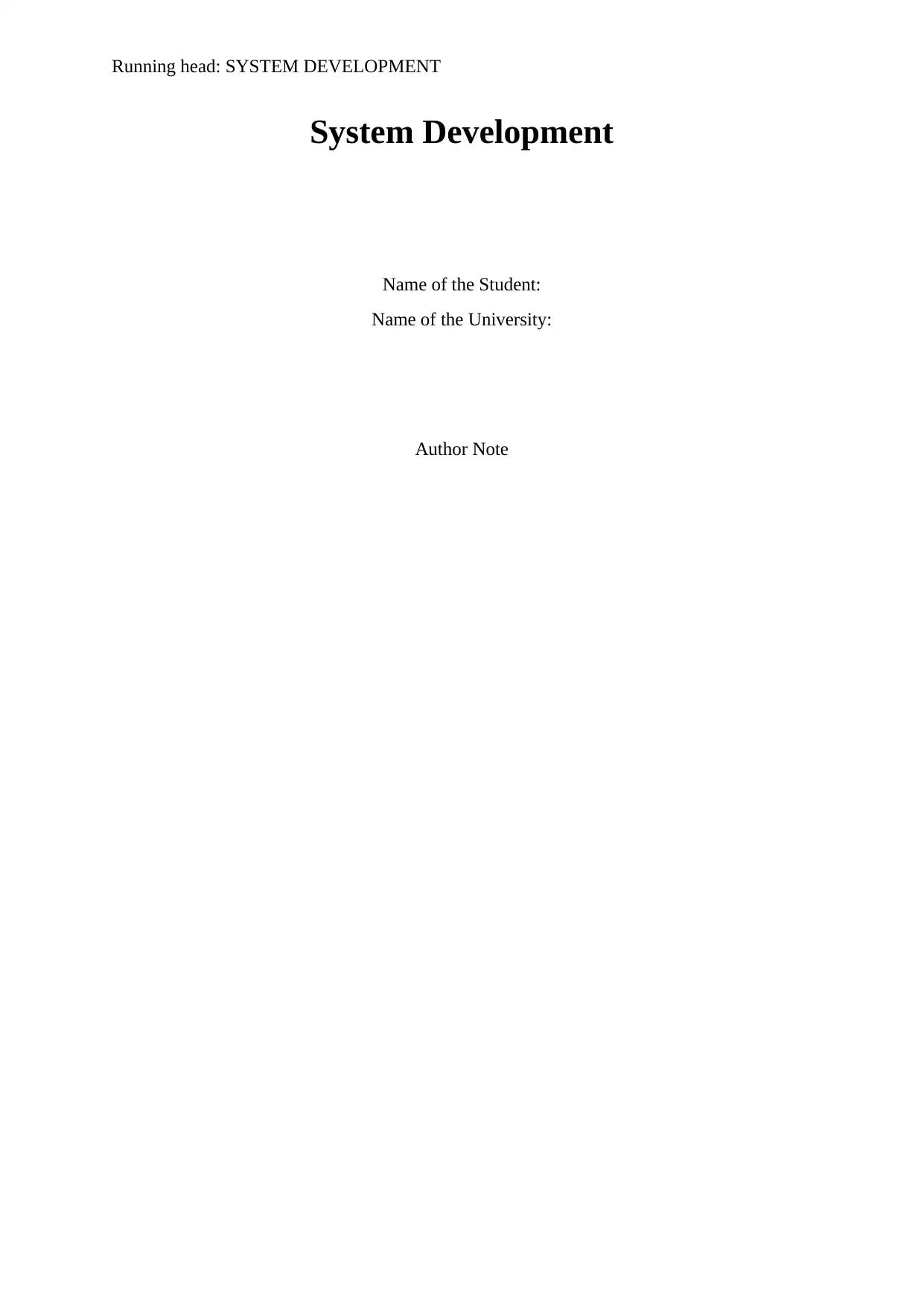
Running head: SYSTEM DEVELOPMENT
System Development
Name of the Student:
Name of the University:
Author Note
System Development
Name of the Student:
Name of the University:
Author Note
Secure Best Marks with AI Grader
Need help grading? Try our AI Grader for instant feedback on your assignments.
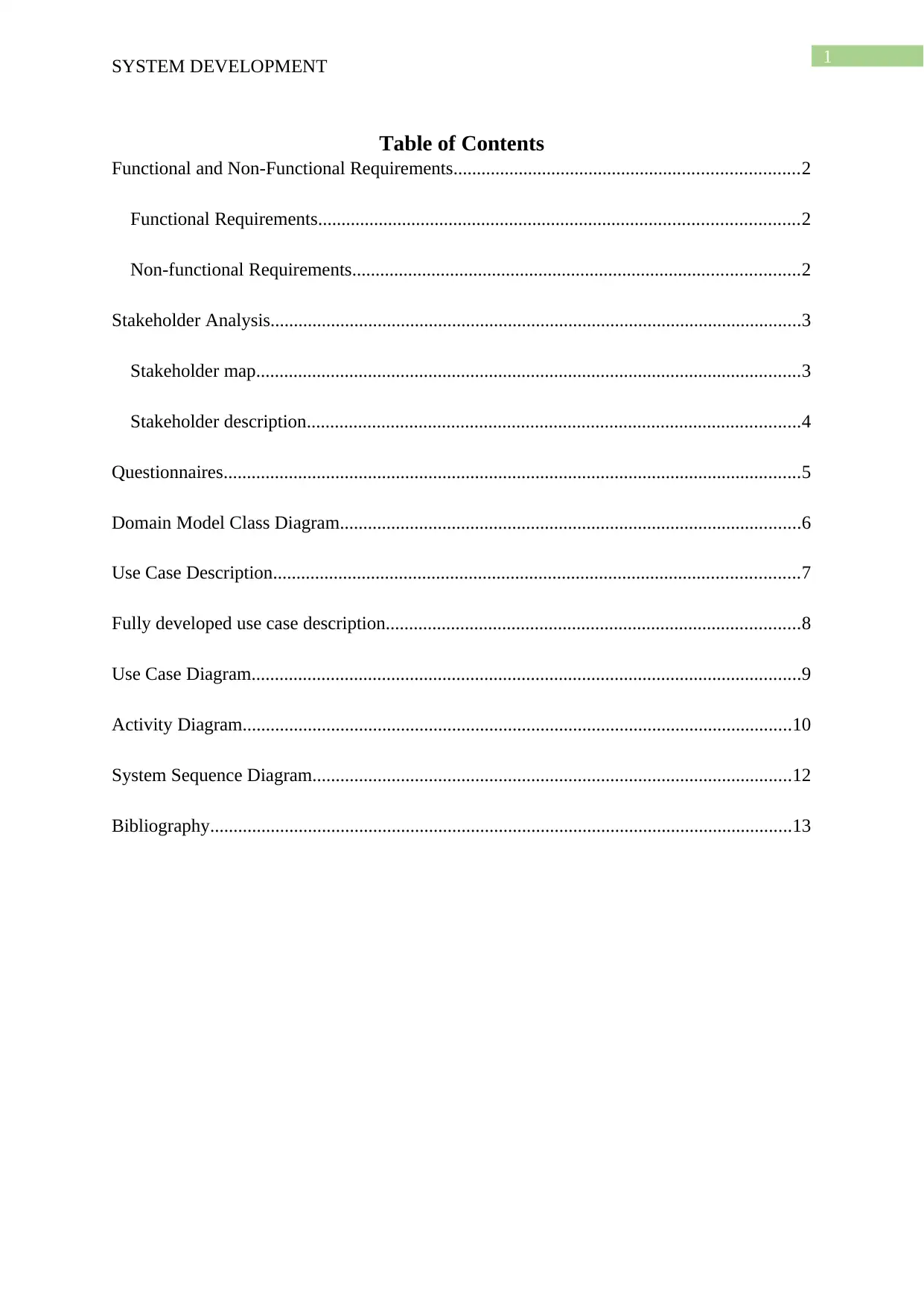
1
SYSTEM DEVELOPMENT
Table of Contents
Functional and Non-Functional Requirements..........................................................................2
Functional Requirements.......................................................................................................2
Non-functional Requirements................................................................................................2
Stakeholder Analysis..................................................................................................................3
Stakeholder map.....................................................................................................................3
Stakeholder description..........................................................................................................4
Questionnaires............................................................................................................................5
Domain Model Class Diagram...................................................................................................6
Use Case Description.................................................................................................................7
Fully developed use case description.........................................................................................8
Use Case Diagram......................................................................................................................9
Activity Diagram......................................................................................................................10
System Sequence Diagram.......................................................................................................12
Bibliography.............................................................................................................................13
SYSTEM DEVELOPMENT
Table of Contents
Functional and Non-Functional Requirements..........................................................................2
Functional Requirements.......................................................................................................2
Non-functional Requirements................................................................................................2
Stakeholder Analysis..................................................................................................................3
Stakeholder map.....................................................................................................................3
Stakeholder description..........................................................................................................4
Questionnaires............................................................................................................................5
Domain Model Class Diagram...................................................................................................6
Use Case Description.................................................................................................................7
Fully developed use case description.........................................................................................8
Use Case Diagram......................................................................................................................9
Activity Diagram......................................................................................................................10
System Sequence Diagram.......................................................................................................12
Bibliography.............................................................................................................................13
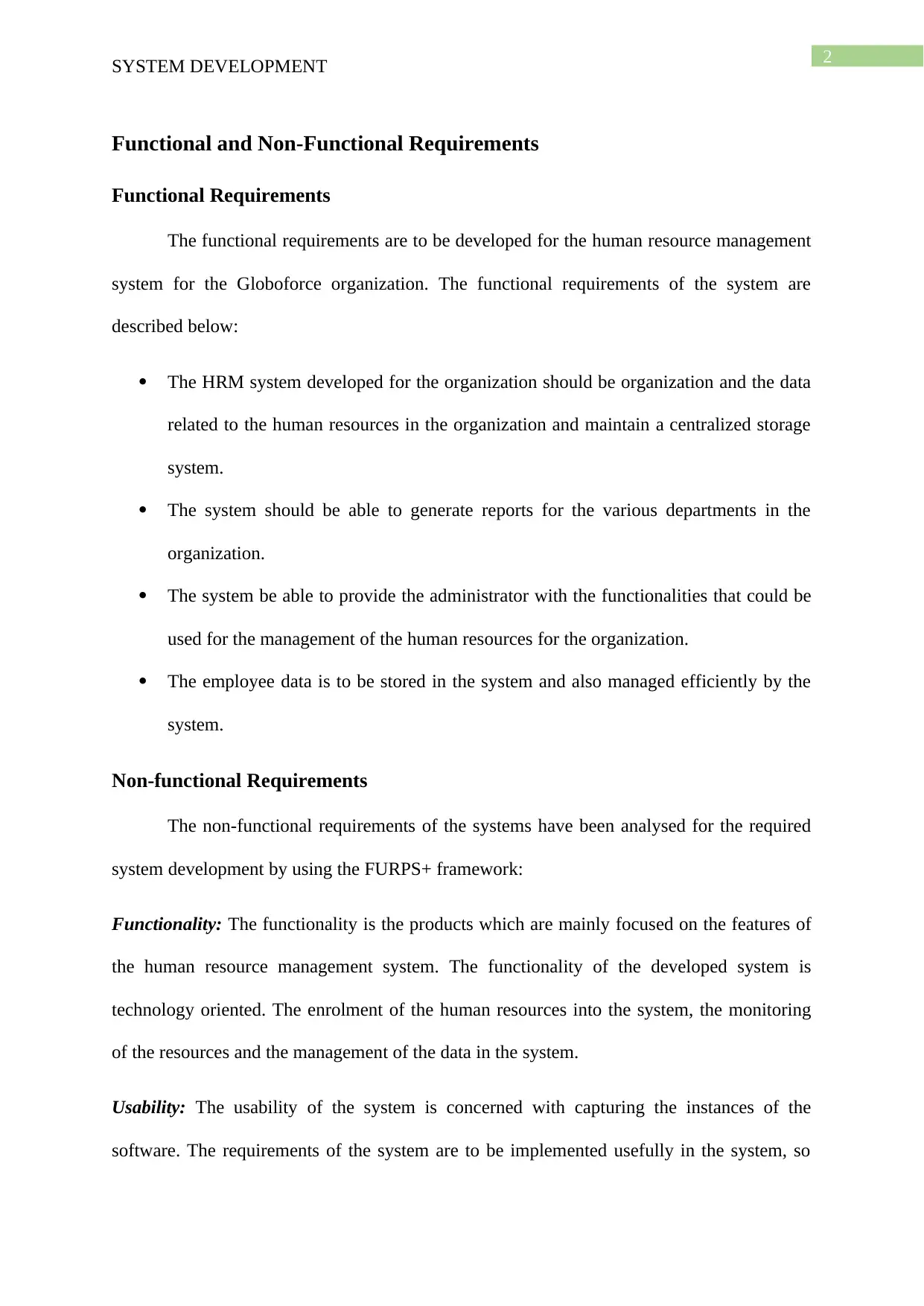
2
SYSTEM DEVELOPMENT
Functional and Non-Functional Requirements
Functional Requirements
The functional requirements are to be developed for the human resource management
system for the Globoforce organization. The functional requirements of the system are
described below:
The HRM system developed for the organization should be organization and the data
related to the human resources in the organization and maintain a centralized storage
system.
The system should be able to generate reports for the various departments in the
organization.
The system be able to provide the administrator with the functionalities that could be
used for the management of the human resources for the organization.
The employee data is to be stored in the system and also managed efficiently by the
system.
Non-functional Requirements
The non-functional requirements of the systems have been analysed for the required
system development by using the FURPS+ framework:
Functionality: The functionality is the products which are mainly focused on the features of
the human resource management system. The functionality of the developed system is
technology oriented. The enrolment of the human resources into the system, the monitoring
of the resources and the management of the data in the system.
Usability: The usability of the system is concerned with capturing the instances of the
software. The requirements of the system are to be implemented usefully in the system, so
SYSTEM DEVELOPMENT
Functional and Non-Functional Requirements
Functional Requirements
The functional requirements are to be developed for the human resource management
system for the Globoforce organization. The functional requirements of the system are
described below:
The HRM system developed for the organization should be organization and the data
related to the human resources in the organization and maintain a centralized storage
system.
The system should be able to generate reports for the various departments in the
organization.
The system be able to provide the administrator with the functionalities that could be
used for the management of the human resources for the organization.
The employee data is to be stored in the system and also managed efficiently by the
system.
Non-functional Requirements
The non-functional requirements of the systems have been analysed for the required
system development by using the FURPS+ framework:
Functionality: The functionality is the products which are mainly focused on the features of
the human resource management system. The functionality of the developed system is
technology oriented. The enrolment of the human resources into the system, the monitoring
of the resources and the management of the data in the system.
Usability: The usability of the system is concerned with capturing the instances of the
software. The requirements of the system are to be implemented usefully in the system, so
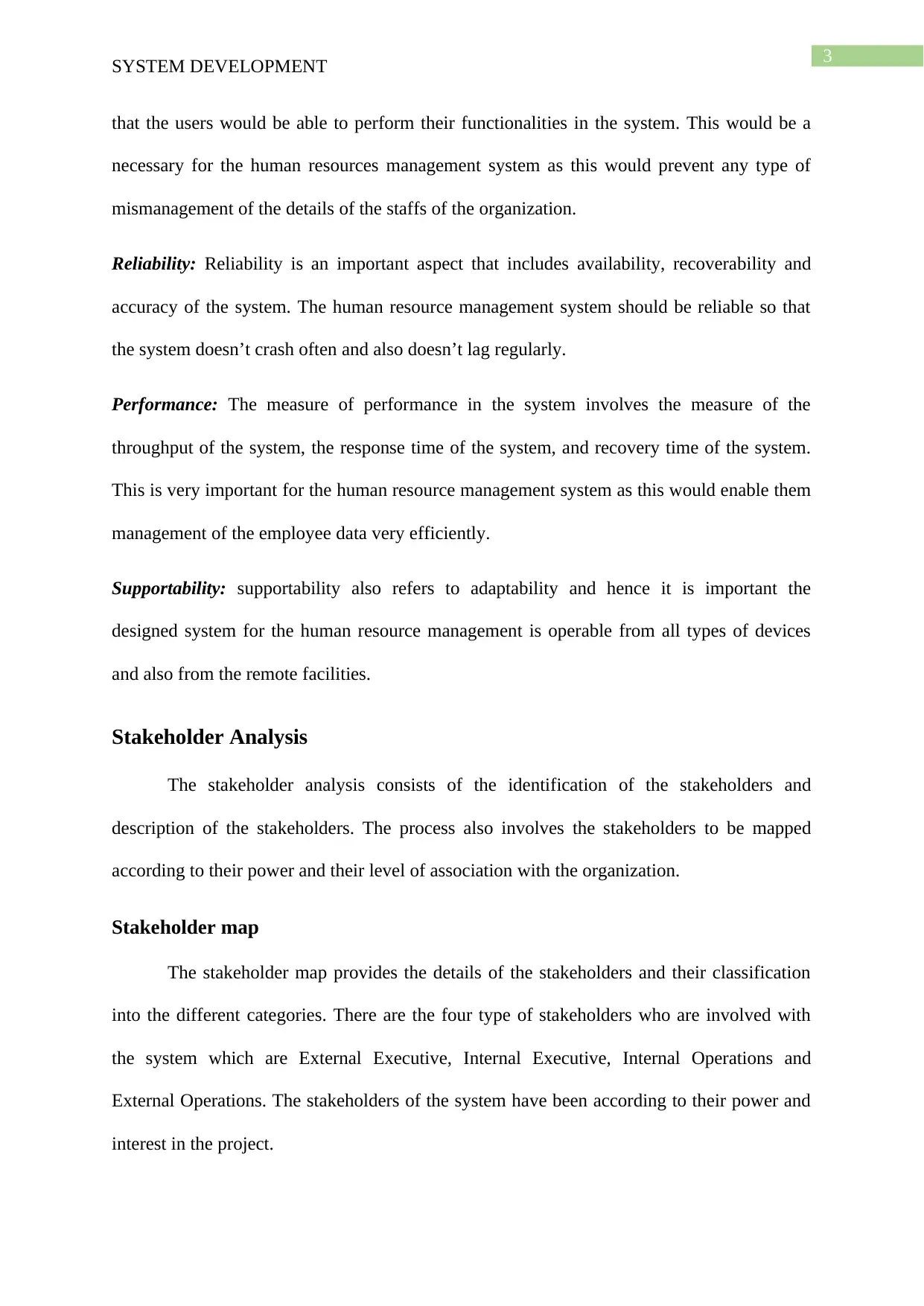
3
SYSTEM DEVELOPMENT
that the users would be able to perform their functionalities in the system. This would be a
necessary for the human resources management system as this would prevent any type of
mismanagement of the details of the staffs of the organization.
Reliability: Reliability is an important aspect that includes availability, recoverability and
accuracy of the system. The human resource management system should be reliable so that
the system doesn’t crash often and also doesn’t lag regularly.
Performance: The measure of performance in the system involves the measure of the
throughput of the system, the response time of the system, and recovery time of the system.
This is very important for the human resource management system as this would enable them
management of the employee data very efficiently.
Supportability: supportability also refers to adaptability and hence it is important the
designed system for the human resource management is operable from all types of devices
and also from the remote facilities.
Stakeholder Analysis
The stakeholder analysis consists of the identification of the stakeholders and
description of the stakeholders. The process also involves the stakeholders to be mapped
according to their power and their level of association with the organization.
Stakeholder map
The stakeholder map provides the details of the stakeholders and their classification
into the different categories. There are the four type of stakeholders who are involved with
the system which are External Executive, Internal Executive, Internal Operations and
External Operations. The stakeholders of the system have been according to their power and
interest in the project.
SYSTEM DEVELOPMENT
that the users would be able to perform their functionalities in the system. This would be a
necessary for the human resources management system as this would prevent any type of
mismanagement of the details of the staffs of the organization.
Reliability: Reliability is an important aspect that includes availability, recoverability and
accuracy of the system. The human resource management system should be reliable so that
the system doesn’t crash often and also doesn’t lag regularly.
Performance: The measure of performance in the system involves the measure of the
throughput of the system, the response time of the system, and recovery time of the system.
This is very important for the human resource management system as this would enable them
management of the employee data very efficiently.
Supportability: supportability also refers to adaptability and hence it is important the
designed system for the human resource management is operable from all types of devices
and also from the remote facilities.
Stakeholder Analysis
The stakeholder analysis consists of the identification of the stakeholders and
description of the stakeholders. The process also involves the stakeholders to be mapped
according to their power and their level of association with the organization.
Stakeholder map
The stakeholder map provides the details of the stakeholders and their classification
into the different categories. There are the four type of stakeholders who are involved with
the system which are External Executive, Internal Executive, Internal Operations and
External Operations. The stakeholders of the system have been according to their power and
interest in the project.
Secure Best Marks with AI Grader
Need help grading? Try our AI Grader for instant feedback on your assignments.
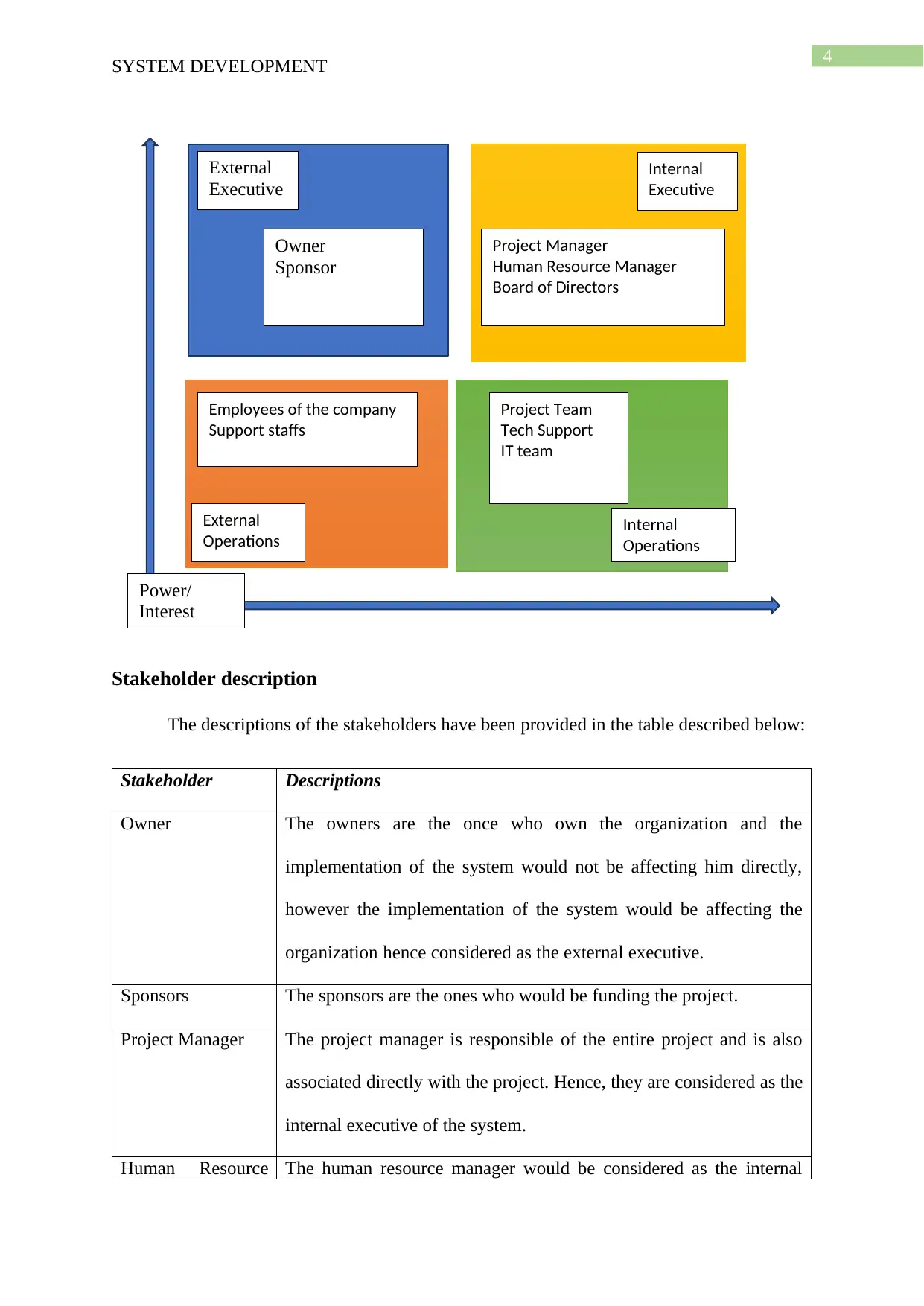
4
Power/
Interest
External
Executive
Internal
Executive
External
Operations Internal
Operations
Owner
Sponsor
Project Manager
Human Resource Manager
Board of Directors
Employees of the company
Support staffs
Project Team
Tech Support
IT team
SYSTEM DEVELOPMENT
Stakeholder description
The descriptions of the stakeholders have been provided in the table described below:
Stakeholder Descriptions
Owner The owners are the once who own the organization and the
implementation of the system would not be affecting him directly,
however the implementation of the system would be affecting the
organization hence considered as the external executive.
Sponsors The sponsors are the ones who would be funding the project.
Project Manager The project manager is responsible of the entire project and is also
associated directly with the project. Hence, they are considered as the
internal executive of the system.
Human Resource The human resource manager would be considered as the internal
Power/
Interest
External
Executive
Internal
Executive
External
Operations Internal
Operations
Owner
Sponsor
Project Manager
Human Resource Manager
Board of Directors
Employees of the company
Support staffs
Project Team
Tech Support
IT team
SYSTEM DEVELOPMENT
Stakeholder description
The descriptions of the stakeholders have been provided in the table described below:
Stakeholder Descriptions
Owner The owners are the once who own the organization and the
implementation of the system would not be affecting him directly,
however the implementation of the system would be affecting the
organization hence considered as the external executive.
Sponsors The sponsors are the ones who would be funding the project.
Project Manager The project manager is responsible of the entire project and is also
associated directly with the project. Hence, they are considered as the
internal executive of the system.
Human Resource The human resource manager would be considered as the internal
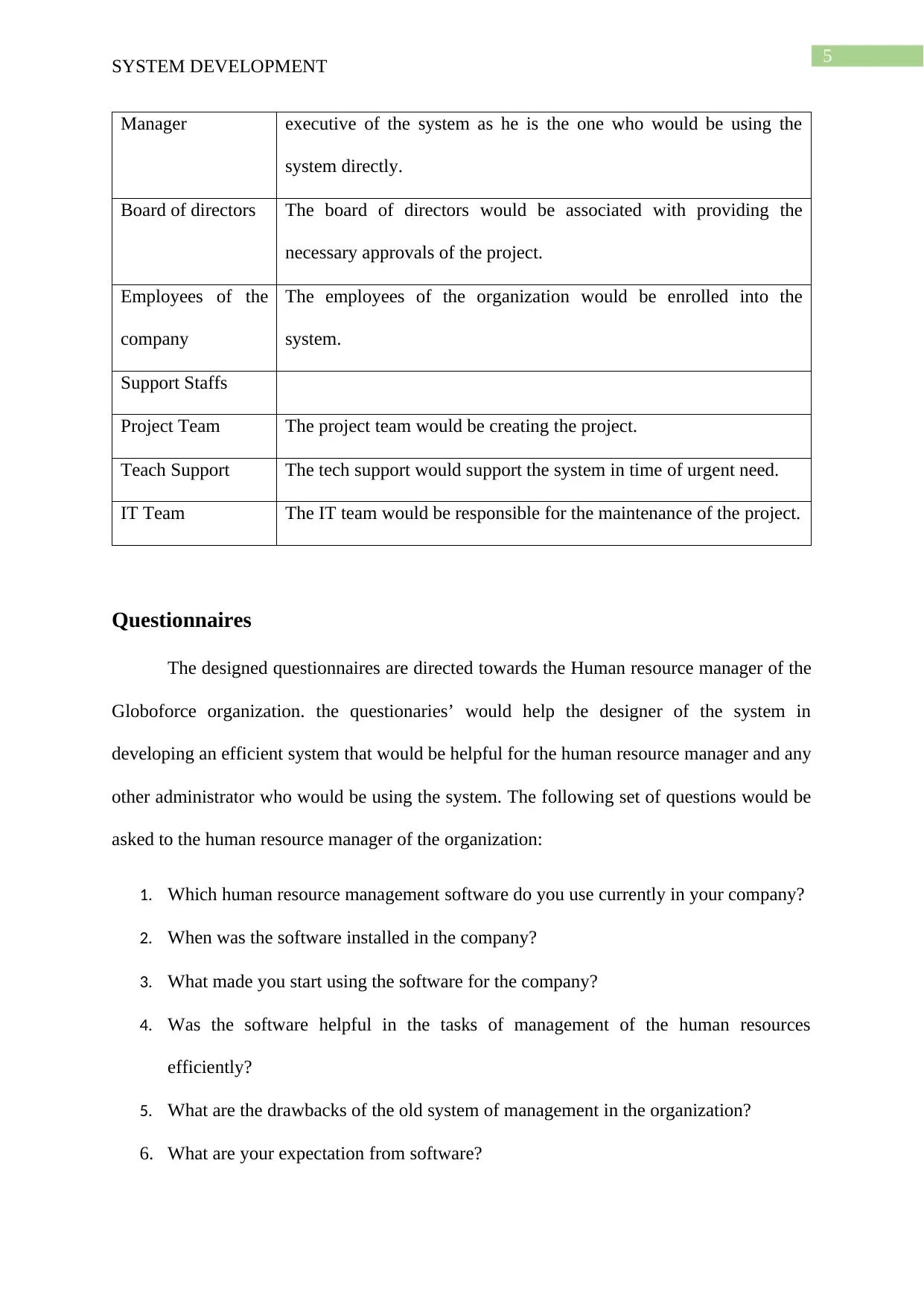
5
SYSTEM DEVELOPMENT
Manager executive of the system as he is the one who would be using the
system directly.
Board of directors The board of directors would be associated with providing the
necessary approvals of the project.
Employees of the
company
The employees of the organization would be enrolled into the
system.
Support Staffs
Project Team The project team would be creating the project.
Teach Support The tech support would support the system in time of urgent need.
IT Team The IT team would be responsible for the maintenance of the project.
Questionnaires
The designed questionnaires are directed towards the Human resource manager of the
Globoforce organization. the questionaries’ would help the designer of the system in
developing an efficient system that would be helpful for the human resource manager and any
other administrator who would be using the system. The following set of questions would be
asked to the human resource manager of the organization:
1. Which human resource management software do you use currently in your company?
2. When was the software installed in the company?
3. What made you start using the software for the company?
4. Was the software helpful in the tasks of management of the human resources
efficiently?
5. What are the drawbacks of the old system of management in the organization?
6. What are your expectation from software?
SYSTEM DEVELOPMENT
Manager executive of the system as he is the one who would be using the
system directly.
Board of directors The board of directors would be associated with providing the
necessary approvals of the project.
Employees of the
company
The employees of the organization would be enrolled into the
system.
Support Staffs
Project Team The project team would be creating the project.
Teach Support The tech support would support the system in time of urgent need.
IT Team The IT team would be responsible for the maintenance of the project.
Questionnaires
The designed questionnaires are directed towards the Human resource manager of the
Globoforce organization. the questionaries’ would help the designer of the system in
developing an efficient system that would be helpful for the human resource manager and any
other administrator who would be using the system. The following set of questions would be
asked to the human resource manager of the organization:
1. Which human resource management software do you use currently in your company?
2. When was the software installed in the company?
3. What made you start using the software for the company?
4. Was the software helpful in the tasks of management of the human resources
efficiently?
5. What are the drawbacks of the old system of management in the organization?
6. What are your expectation from software?
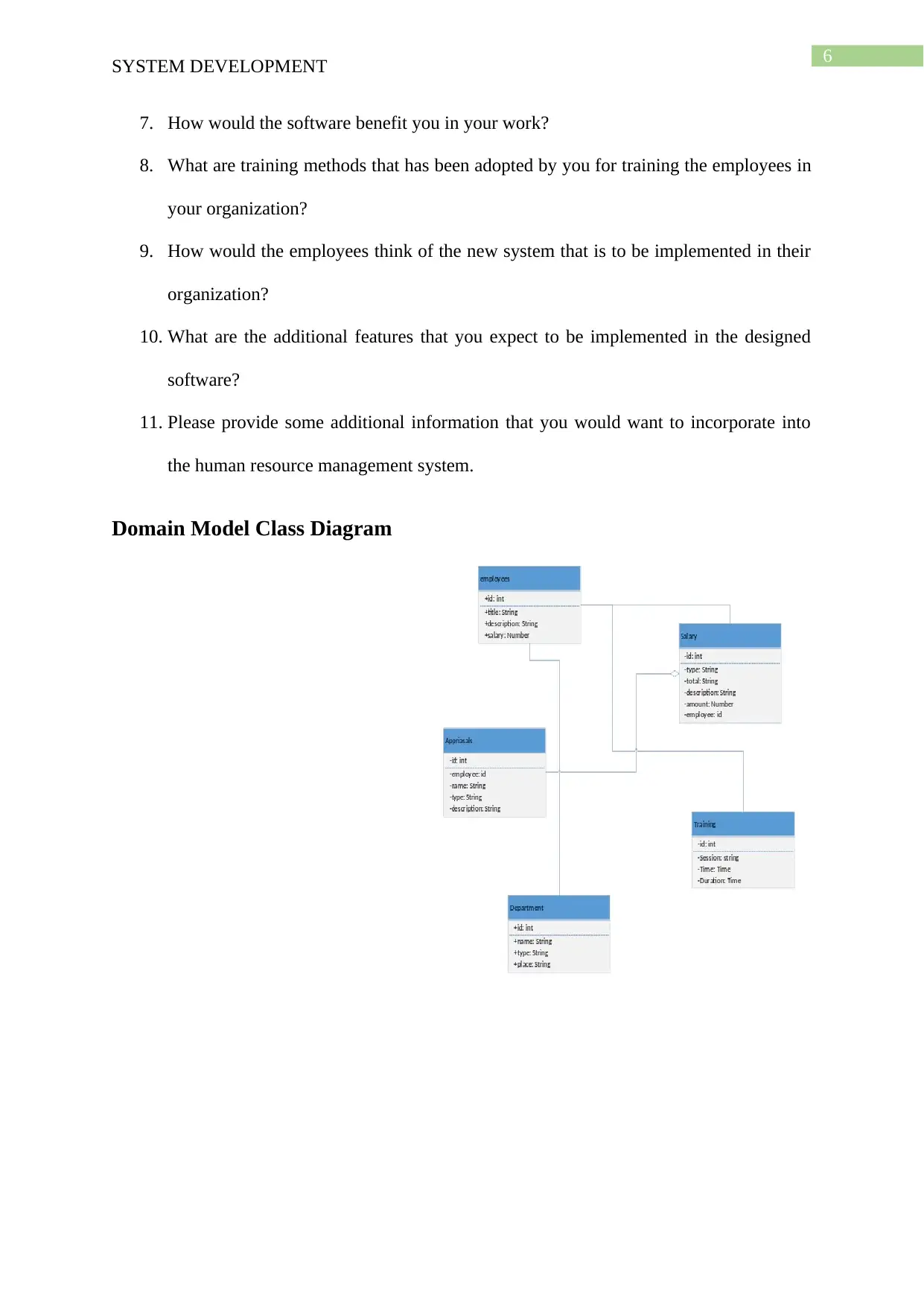
6
SYSTEM DEVELOPMENT
7. How would the software benefit you in your work?
8. What are training methods that has been adopted by you for training the employees in
your organization?
9. How would the employees think of the new system that is to be implemented in their
organization?
10. What are the additional features that you expect to be implemented in the designed
software?
11. Please provide some additional information that you would want to incorporate into
the human resource management system.
Domain Model Class Diagram
SYSTEM DEVELOPMENT
7. How would the software benefit you in your work?
8. What are training methods that has been adopted by you for training the employees in
your organization?
9. How would the employees think of the new system that is to be implemented in their
organization?
10. What are the additional features that you expect to be implemented in the designed
software?
11. Please provide some additional information that you would want to incorporate into
the human resource management system.
Domain Model Class Diagram
Paraphrase This Document
Need a fresh take? Get an instant paraphrase of this document with our AI Paraphraser
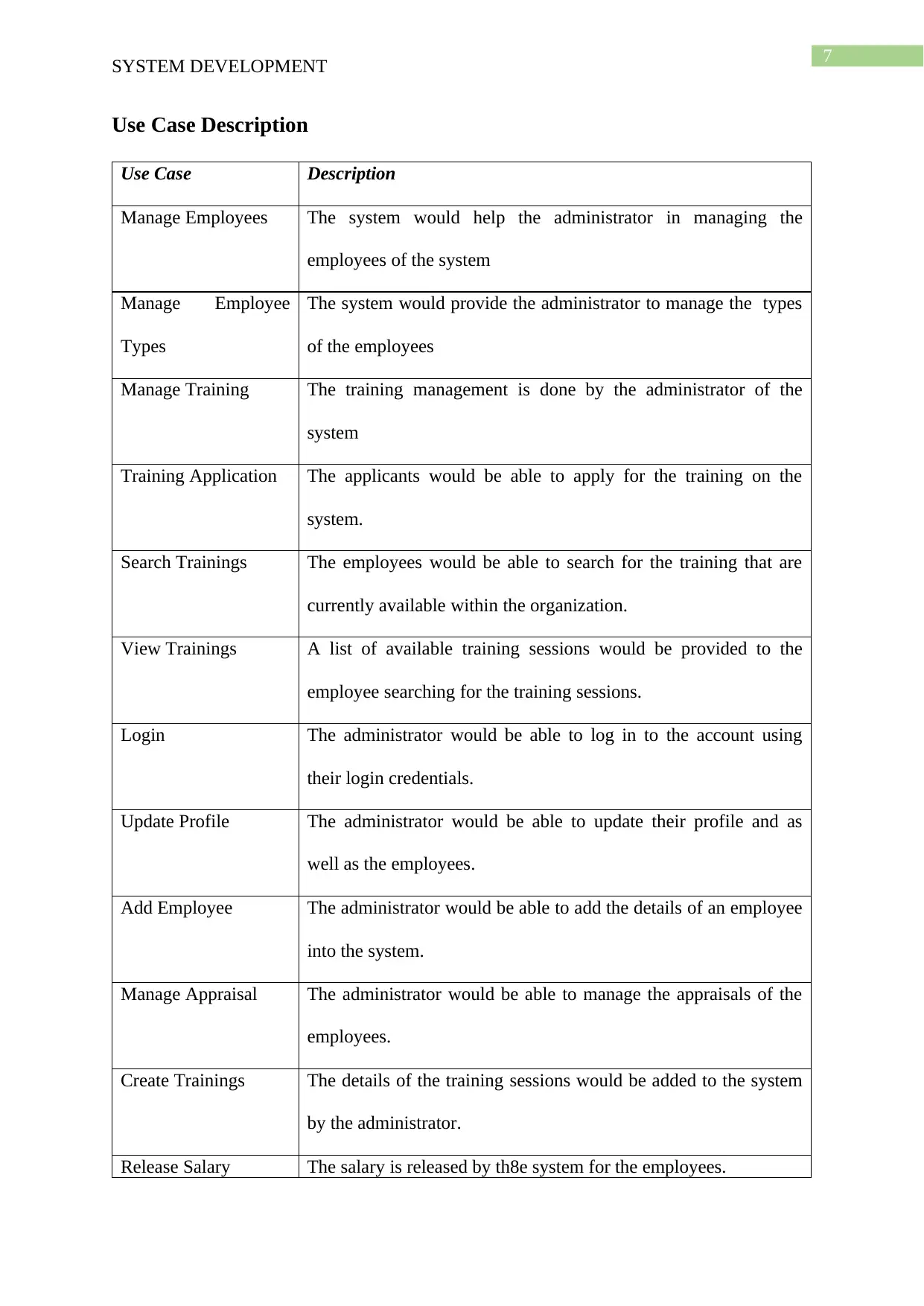
7
SYSTEM DEVELOPMENT
Use Case Description
Use Case Description
Manage Employees The system would help the administrator in managing the
employees of the system
Manage Employee
Types
The system would provide the administrator to manage the types
of the employees
Manage Training The training management is done by the administrator of the
system
Training Application The applicants would be able to apply for the training on the
system.
Search Trainings The employees would be able to search for the training that are
currently available within the organization.
View Trainings A list of available training sessions would be provided to the
employee searching for the training sessions.
Login The administrator would be able to log in to the account using
their login credentials.
Update Profile The administrator would be able to update their profile and as
well as the employees.
Add Employee The administrator would be able to add the details of an employee
into the system.
Manage Appraisal The administrator would be able to manage the appraisals of the
employees.
Create Trainings The details of the training sessions would be added to the system
by the administrator.
Release Salary The salary is released by th8e system for the employees.
SYSTEM DEVELOPMENT
Use Case Description
Use Case Description
Manage Employees The system would help the administrator in managing the
employees of the system
Manage Employee
Types
The system would provide the administrator to manage the types
of the employees
Manage Training The training management is done by the administrator of the
system
Training Application The applicants would be able to apply for the training on the
system.
Search Trainings The employees would be able to search for the training that are
currently available within the organization.
View Trainings A list of available training sessions would be provided to the
employee searching for the training sessions.
Login The administrator would be able to log in to the account using
their login credentials.
Update Profile The administrator would be able to update their profile and as
well as the employees.
Add Employee The administrator would be able to add the details of an employee
into the system.
Manage Appraisal The administrator would be able to manage the appraisals of the
employees.
Create Trainings The details of the training sessions would be added to the system
by the administrator.
Release Salary The salary is released by th8e system for the employees.
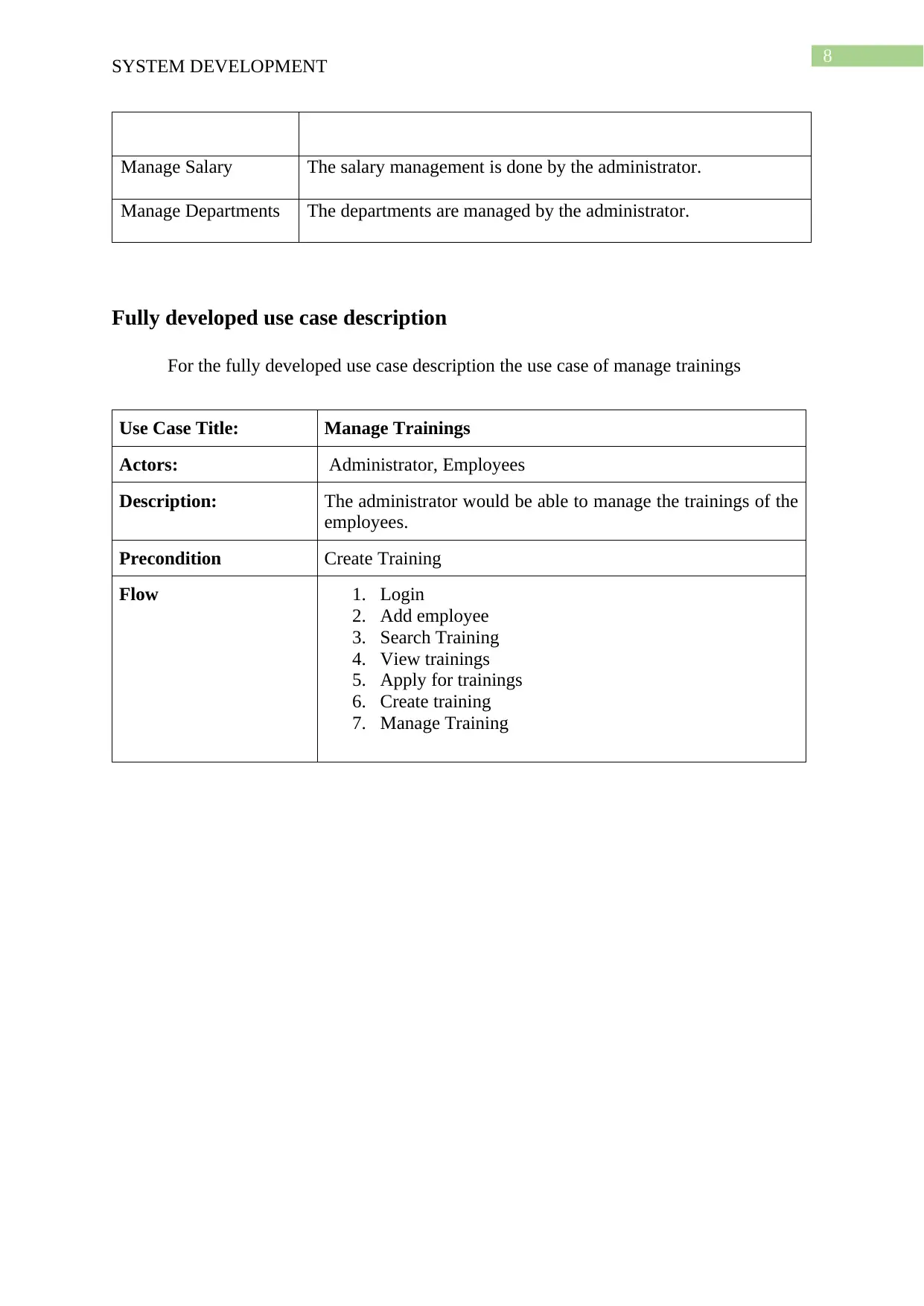
8
SYSTEM DEVELOPMENT
Manage Salary The salary management is done by the administrator.
Manage Departments The departments are managed by the administrator.
Fully developed use case description
For the fully developed use case description the use case of manage trainings
Use Case Title: Manage Trainings
Actors: Administrator, Employees
Description: The administrator would be able to manage the trainings of the
employees.
Precondition Create Training
Flow 1. Login
2. Add employee
3. Search Training
4. View trainings
5. Apply for trainings
6. Create training
7. Manage Training
SYSTEM DEVELOPMENT
Manage Salary The salary management is done by the administrator.
Manage Departments The departments are managed by the administrator.
Fully developed use case description
For the fully developed use case description the use case of manage trainings
Use Case Title: Manage Trainings
Actors: Administrator, Employees
Description: The administrator would be able to manage the trainings of the
employees.
Precondition Create Training
Flow 1. Login
2. Add employee
3. Search Training
4. View trainings
5. Apply for trainings
6. Create training
7. Manage Training
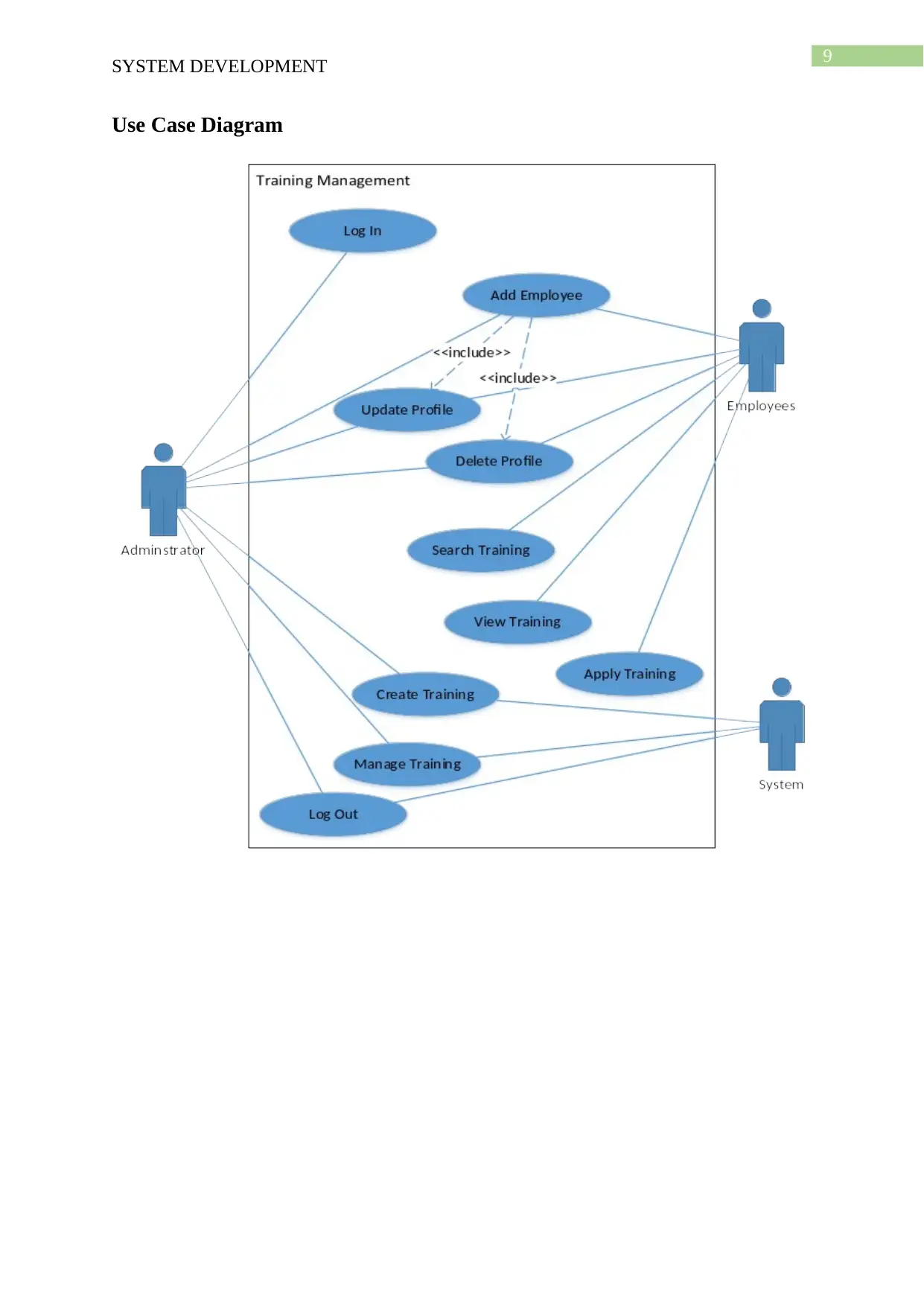
9
SYSTEM DEVELOPMENT
Use Case Diagram
SYSTEM DEVELOPMENT
Use Case Diagram
Secure Best Marks with AI Grader
Need help grading? Try our AI Grader for instant feedback on your assignments.
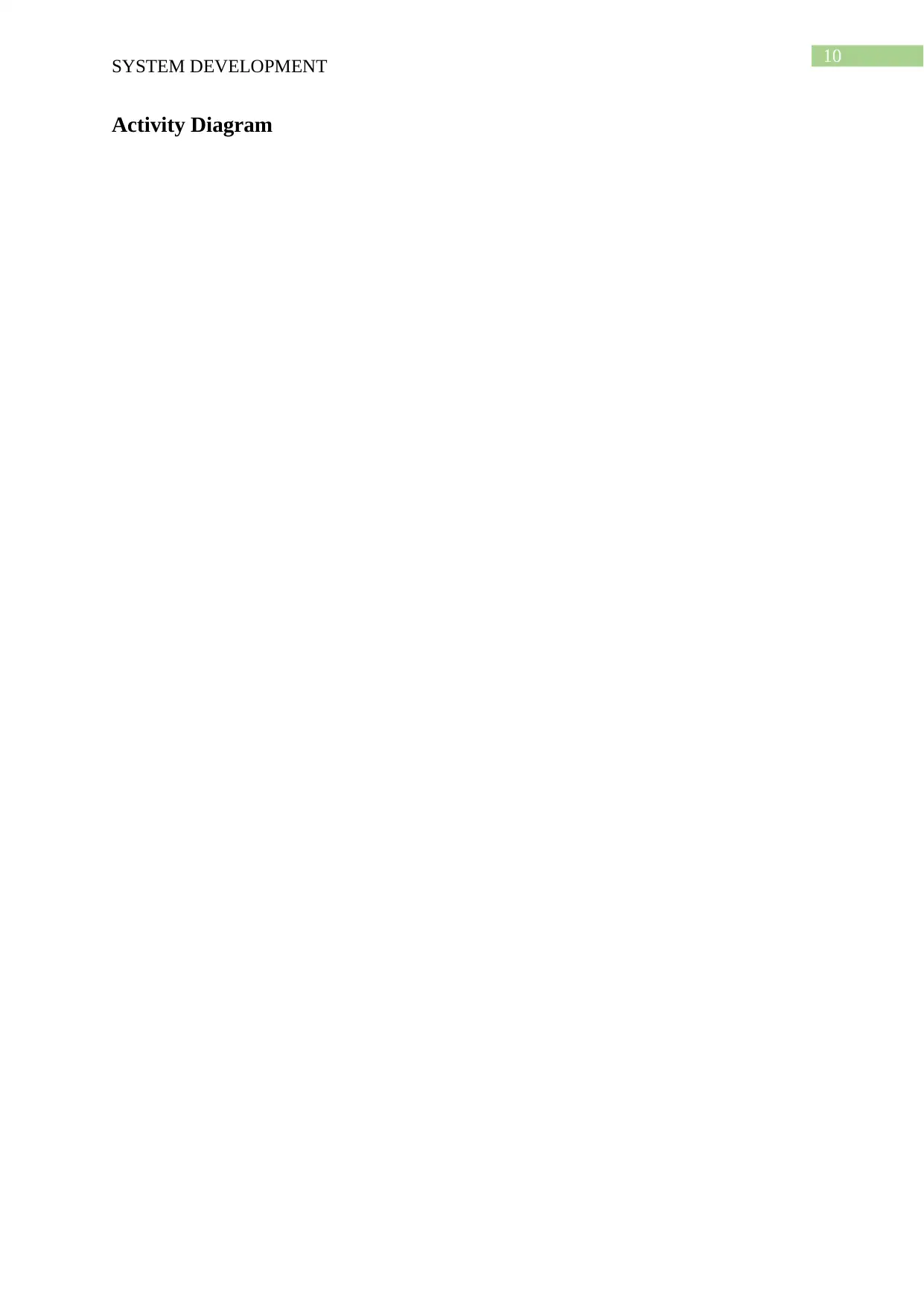
10
SYSTEM DEVELOPMENT
Activity Diagram
SYSTEM DEVELOPMENT
Activity Diagram
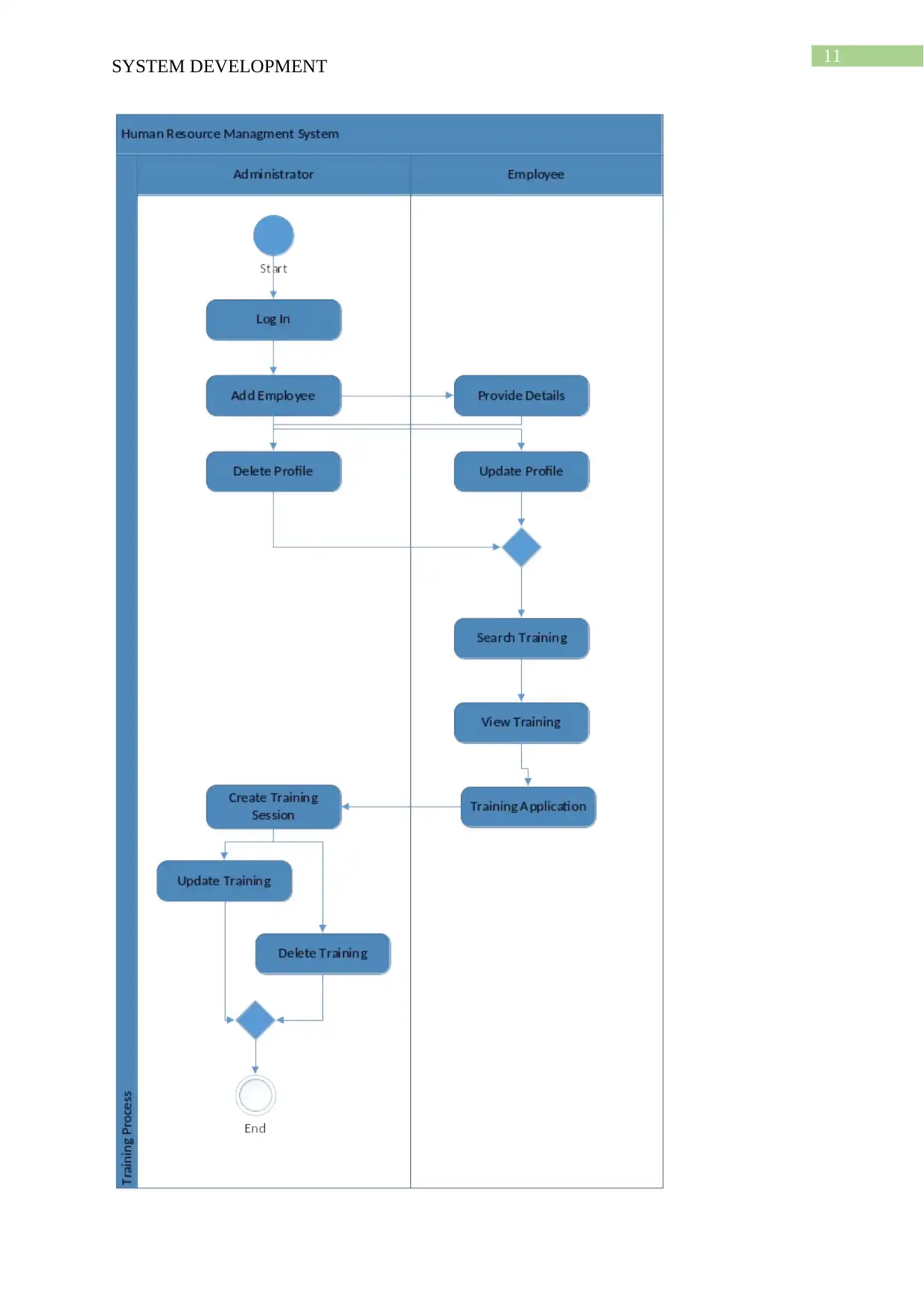
11
SYSTEM DEVELOPMENT
SYSTEM DEVELOPMENT
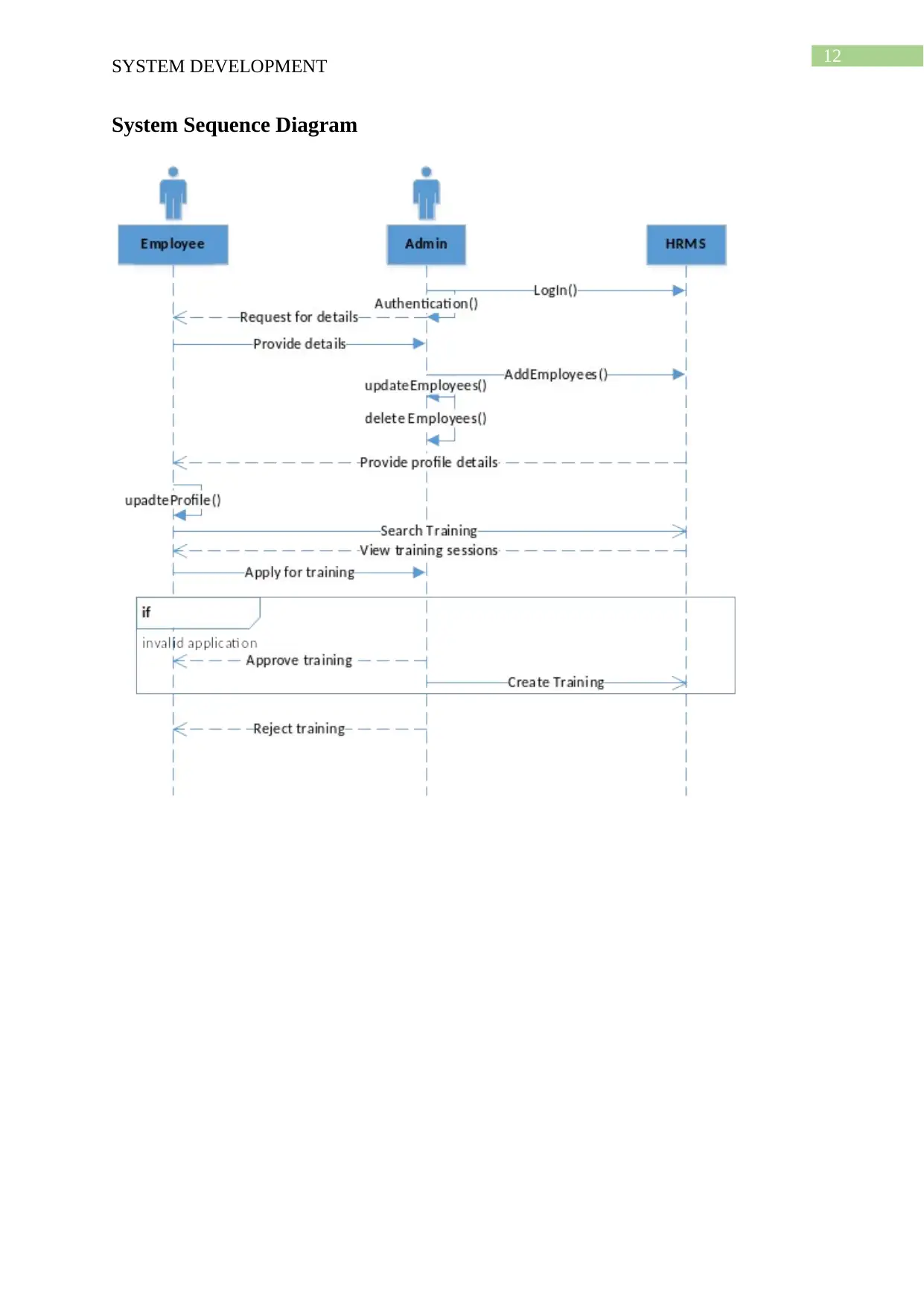
12
SYSTEM DEVELOPMENT
System Sequence Diagram
SYSTEM DEVELOPMENT
System Sequence Diagram
Paraphrase This Document
Need a fresh take? Get an instant paraphrase of this document with our AI Paraphraser
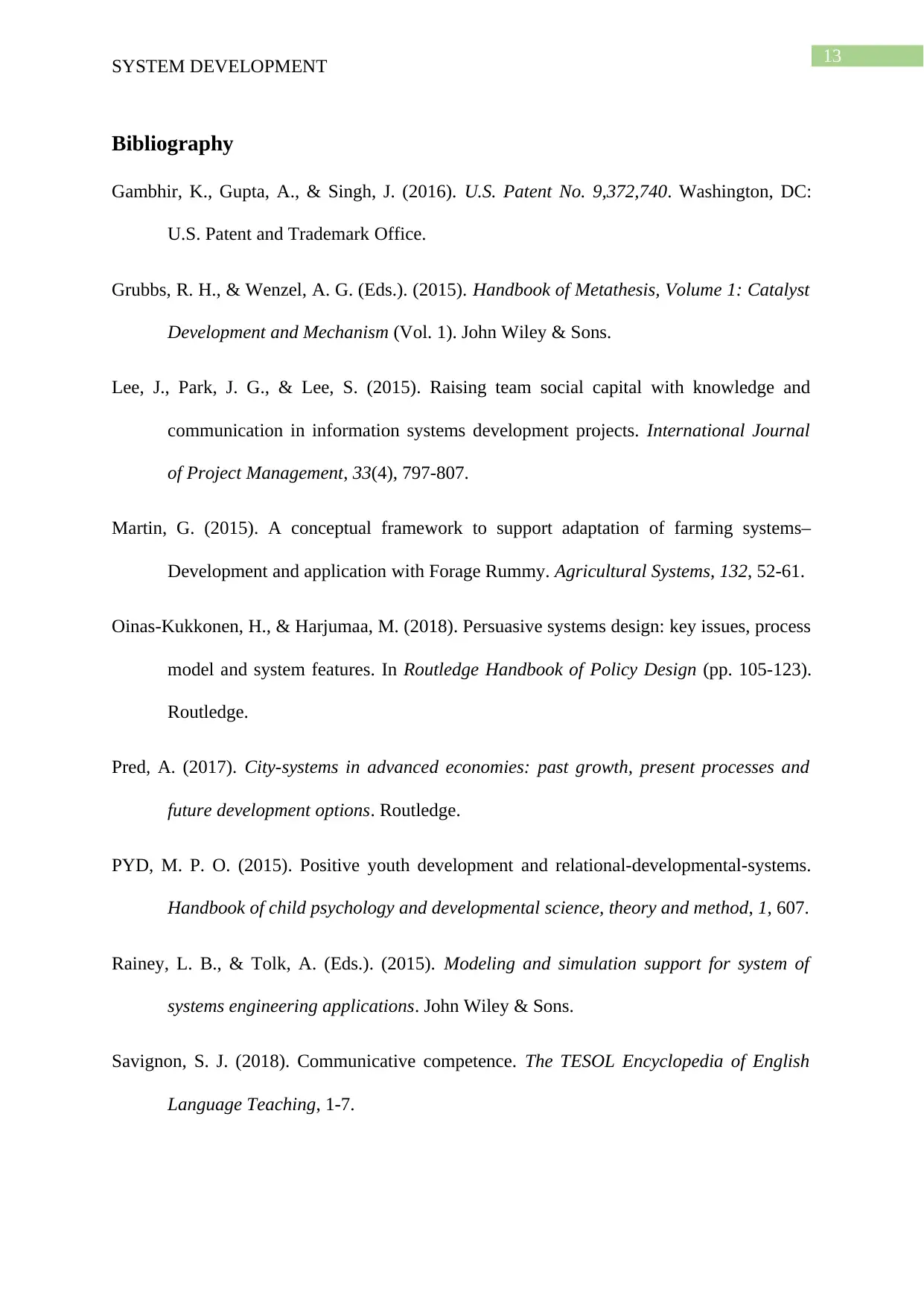
13
SYSTEM DEVELOPMENT
Bibliography
Gambhir, K., Gupta, A., & Singh, J. (2016). U.S. Patent No. 9,372,740. Washington, DC:
U.S. Patent and Trademark Office.
Grubbs, R. H., & Wenzel, A. G. (Eds.). (2015). Handbook of Metathesis, Volume 1: Catalyst
Development and Mechanism (Vol. 1). John Wiley & Sons.
Lee, J., Park, J. G., & Lee, S. (2015). Raising team social capital with knowledge and
communication in information systems development projects. International Journal
of Project Management, 33(4), 797-807.
Martin, G. (2015). A conceptual framework to support adaptation of farming systems–
Development and application with Forage Rummy. Agricultural Systems, 132, 52-61.
Oinas-Kukkonen, H., & Harjumaa, M. (2018). Persuasive systems design: key issues, process
model and system features. In Routledge Handbook of Policy Design (pp. 105-123).
Routledge.
Pred, A. (2017). City-systems in advanced economies: past growth, present processes and
future development options. Routledge.
PYD, M. P. O. (2015). Positive youth development and relational-developmental-systems.
Handbook of child psychology and developmental science, theory and method, 1, 607.
Rainey, L. B., & Tolk, A. (Eds.). (2015). Modeling and simulation support for system of
systems engineering applications. John Wiley & Sons.
Savignon, S. J. (2018). Communicative competence. The TESOL Encyclopedia of English
Language Teaching, 1-7.
SYSTEM DEVELOPMENT
Bibliography
Gambhir, K., Gupta, A., & Singh, J. (2016). U.S. Patent No. 9,372,740. Washington, DC:
U.S. Patent and Trademark Office.
Grubbs, R. H., & Wenzel, A. G. (Eds.). (2015). Handbook of Metathesis, Volume 1: Catalyst
Development and Mechanism (Vol. 1). John Wiley & Sons.
Lee, J., Park, J. G., & Lee, S. (2015). Raising team social capital with knowledge and
communication in information systems development projects. International Journal
of Project Management, 33(4), 797-807.
Martin, G. (2015). A conceptual framework to support adaptation of farming systems–
Development and application with Forage Rummy. Agricultural Systems, 132, 52-61.
Oinas-Kukkonen, H., & Harjumaa, M. (2018). Persuasive systems design: key issues, process
model and system features. In Routledge Handbook of Policy Design (pp. 105-123).
Routledge.
Pred, A. (2017). City-systems in advanced economies: past growth, present processes and
future development options. Routledge.
PYD, M. P. O. (2015). Positive youth development and relational-developmental-systems.
Handbook of child psychology and developmental science, theory and method, 1, 607.
Rainey, L. B., & Tolk, A. (Eds.). (2015). Modeling and simulation support for system of
systems engineering applications. John Wiley & Sons.
Savignon, S. J. (2018). Communicative competence. The TESOL Encyclopedia of English
Language Teaching, 1-7.
1 out of 14
Related Documents
Your All-in-One AI-Powered Toolkit for Academic Success.
+13062052269
info@desklib.com
Available 24*7 on WhatsApp / Email
![[object Object]](/_next/static/media/star-bottom.7253800d.svg)
Unlock your academic potential
© 2024 | Zucol Services PVT LTD | All rights reserved.





